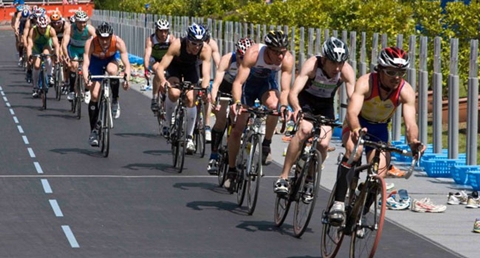Lactate Threshold |
|
The lactate threshold is an important predictor of performance in endurance events. Studies have found high correlations between performance in endurance events such as running, cycling, and swimming and the maximal lactate threshold.
At rest and under steady-state exercise conditions, there is a balance between blood lactate production and blood lactate removal. The lactate threshold refers to the intensity of exercise at which there is an abrupt increase in blood lactate levels. Training programs that are a combination of high volume, maximal steady-state, and interval workouts have the most pronounced effect on lactate threshold improvement.
Although the exact physiological factors of the lactate threshold are not fully understood, it is thought to involve the following key mechanisms:
- 1. Decreased lactate removal. As exercise intensities above the lactate threshold, there is a mismatch between production and uptake, with the rate of lactate removal apparently lagging behind the rate of lactate production.
- 2. Increased fast-twitch motor unit recruitment. As exercise intensifies there is a shift towards the recruitment of fast-twitch muscles, which have metabolic characteristics that are geared towards glycolysis (an anaerobic energy pathway). The recruitment of these muscles shift’s energy metabolism from mitochondrial respiration more towards glycolysis, which leads to increased lactate.
- 3. Imbalance between glycolysis and mitochondrial respiration. At increasing exercise intensities, there is an increased reliance on the rate in the transfer of glucose to pyruvate through the reactions of glycolysis. Some researchers believe that at high rates of glycolysis, pyruvate is produced faster than it can enter into the mitochondria for mitochondrial respiration. Pyruvate that cannot enter the mitochondria will be converted to lactate, which can then be used as fuel elsewhere in the body (such as the liver or other muscles).
4. Low blood flow or low oxygen content in blood. For years, one of the primary causes of lactate production was thought to include low levels of blood flow or low levels of blood oxygen content (hypoxia) to exercising muscles.
Human Growth Hormone
The Human Growth Hormone is an important hormone for men and women that stimulates cell growth and reproduction and is an amino acid produced in the Pituitary Gland. The Pituitary Gland secretes the Growth Hormone into the blood stream for circulation to our bodies cells and organs.
Our objective is to provide you information here on how to increase the natural production of the Growth Hormone for maximum health benefits and improved athletic performance.
Injection of the Growth Hormone is not recommended for healthy individuals as the introduction of the artificial version may negatively impact the body's ability to naturally produce it. Injection of the artificial version is however recommended to treat natural Growth Hormone deficiency or for other medical reasons.
The Growth Hormone is important to the Longevity of everyone, but it is particularly vital to very active people and athletes. People that engage in endurance athletics like Running, Swimming and Cycling should learn what they can do to stimulate the production of this hormone.
What are the functions of the Growth Hormone?
The Growth Hormone has the following vital functions:
- Increases calcium retention
- Increases mineralization of bone
- Stimulate production of bone marrow cells to produce red blood cells
- Increases protein synthesis
- Plays a role in fuel homeostasis
- Stimulates the immune system
- Increases muscle mass
- Increases the growth of all internal organs
- Promotes liver gluconeogenesis
- Promotes lipolysis
Adults deficient in the Growth Hormone have a relative decrease in muscle mass, decreased energy levels, are less vital, and have a lower quality of life.
When is the Growth Hormone released?
The Growth Hormone is released in peaks during a 24 hour period with adolescent averaging 8 peaks and adults average in 5 peaks per day. The amplitude of the release peaks declines throughout the adult years. Hence the importance of living strong and healthy life, through a nutritious diet, regular vigorous exercise, and good sleep to increase the release and forestall the decline of the Growth Hormone release.
The highest concentration of the Growth Hormone occurs about an hour after the first hour of sleep. Another reason why good and regular sleep is a critical factor in achieving Longevity.
What Stimulates the Growth Hormone?
The Growth Hormone is stimulated by:
- Sleep - See 12 Tips to Good Natural Sleep
- Exercise
- Low Blood Sugar Levels
- Arginine (for adults only)
- Ghrelin
There are a number of substances that increase the natural secretion of Growth Hormone. Some of them are amino acids. The most effective and economical way of causing this Growth Hormone release appears to be taking 2 grams of the amino acid L-glutamine in the morning and taking 10 to 30 grams of the amino acid L-arginine before bedtime.
What Inhibits the Growth Hormone?
- Hyperglycemia or High Blood Sugar Levels
- Exessive Estrogen
- Worry
- Lack of Sleep
- Free fatty acids
Competition and Win Desire
Competition provides us with the opportunity to face our own moment of truth. The truth about our strengths, weaknesses, challenges, objectives and the extent to which we are real to ourselves.
Competition requires and develops toughness. Toughness that enables consistent performance at the upper range of talent and skill.
Toughness is achieving the emotional flexibility to remain supple, nondefensive and balanced with positive emotions in the face of unexpected challenges.
Toughness is the ability to remain emotionally alive and fully engaged under pressure.
Toughness is sustaining a powerful fighting spirit against impossible odds and great resistance.
Toughness is the resiliency to quickly bounce back from setbacks, mistakes, failures and emotional punches to fully resume the competition with the objective to win.
Toughness is enhanced through a high level of physical fitness.
Mastering the toughness required in athletic achievement increases your chances of effectively coping with the challenges of life.
<-- back to top





